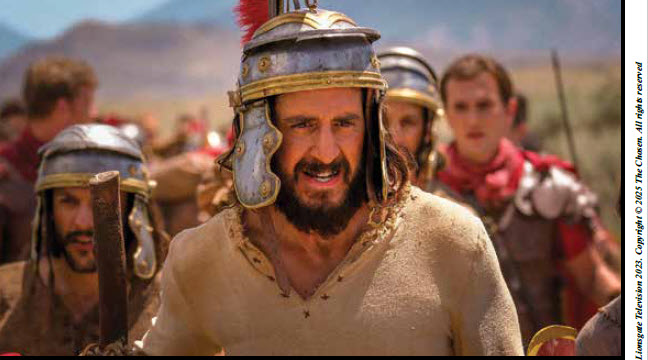 By: Eric Betts
By: Eric Betts
As the real work of Christmas love and generosity extends beyond the actual day of celebration, it is important to reflect upon the profound meaning of a text which is commonly studied during the Advent season:
At that time there was a man in Jerusalem named Simeon. He was righteous and devout and was eagerly waiting for the Messiah to come and rescue Israel. The Holy Spirit was upon him and had revealed to him that he would not die until he had seen the Lord’s Messiah. That day the Spirit led him to the Temple. So, when Mary and Joseph came to present the baby Jesus to the Lord as the law required, Simeon was there. He took the child in his arms and praised God, saying, “I have seen your salvation, which you have prepared for all people. He is a light to reveal God to the nations, and he is the glory of your people Israel!” Jesus’ parents were amazed at what was being said about him. Then Simeon blessed them, and he said to Mary, the baby’s mother, “This child is destined to cause many in Israel to fall, and many others to rise. He has been sent as a sign from God, but many will oppose him. As a result, the deepest thoughts of many hearts will be revealed. And a sword will pierce your very soul. Luke 2:25-28, 30-35
Through the lens of liberation theologians, this biblical passage from the Gospel of Luke may be interpreted as a prophetic vision of liberation and salvation for marginalized and left behind communities. Simeon’s wait for the Messiah indicates an anticipation for divine intervention, which is similar to the longing for liberation and justice among historically pushed aside groups. The text notes that the Messiah is a “light to reveal God to the nations,” suggesting that Christ’s mission embraces every nation, tribe, and tongue, embodying liberation and equality for all people. The prophecy that Jesus will cause many to fall and many others to rise may be seen as a call for societal transformation, where exploitative structures are dismantled and disenfranchised communities are uplifted. Additionally, Simeon’s prediction of Mary’s suffering could be interpreted as a symbolism of the collective pain endured by generations of pushed aside communities, pointing to a liberation that is achieved not without struggle and sacrifice.
Furthermore, Simeon’s prophecy provides a nuanced view of liberation. While the arrival of the Messiah signals a time of joy and salvation, it also entails suffering and upheaval, as indicated by his prediction of Mary’s future sorrow and the downfall of many. This dual imagery reflects the realities of liberation struggles—paving the way to justice often involves challenging confrontations and substantial sacrifices. Ultimately, Simeon’s character and prophecy underscore the central themes of the promise of deliverance, the necessity of active faith, and the understanding that the road to liberation is often marked by hardships and sacrifices.
Consider, my friends, the fortitude of Simeon, who waited for the consolation of Israel, the strength of spirit that he bore within him. Dreary days turned to weeks, weeks to months, months to years, and still he kept his gaze fastened upon the horizon, hungering for the fulfillment of the Lord’s promise. Imagine the silent whispers of doubt that might have sought to creep into his heart, the nagging seeds of skepticism in the face of the passing years. Yet, Simeon stood unyielding, resolute in his faith. He was steadfast, anchored in a hope not of this world, a hope that transcended the trials of time. Every morning, he arose with renewed vigor, scanning the horizon, each passing day a testament to his unwavering belief. His spirit, kindled by divine love, refused to let the flame of hope be extinguished.
Indeed, Simeon embodied the essence of true faith, a faith that hopes against hope, a faith that stands firm in the face of adversity.
Now let’s flip the script for a minute. Unaware of the profound spiritual journey Simeon was traversing, the people around him in the temple went about their routines with a sense of detached indifference. They bustled along the temple corridors, their voices echoing off the ancient stone walls, engaged in their own worlds of rituals and discussions, oblivious to the divine drama unfolding in their midst. Their eyes were fixed on the ground, on their scrolls, on anything but the expectant man fervently seeking a glimpse of the divine promise. They moved with a rhythm of monotony, their gestures robotic, their minds consumed in the mundanity of the day-to-day. Outside, the world was in flux, yet inside the temple, time seemed to stagnate, with little change or excitement to punctuate the rhythm of religious observances. The contrast between Simeon’s active anticipation and the passive indifference of his fellow temple-goers was stark and palpable. The spiritual fortitude that Simeon bore within stood out against the backdrop of oblivious routine, casting him as a lone beacon of faith and hope among a sea of complacency.
This stark contrast between Simeon’s fervent faith and the indifference of his contemporaries serves as a potent reminder for the readers of today. In our fast-paced world, where we are often caught up in our own routines and responsibilities, it is all too easy to lose sight of the bigger picture, to become indifferent to the divine drama unfolding around us. We can become so engrossed in our own realms of work, responsibilities, and personal pursuits, we forget to actively anticipate and seek the divine promises in our own lives.
To avoid falling into a similar pattern of passive indifference, it is essential that we intentionally cultivate an attitude of active anticipation, just like Simeon. This involves pausing, reflecting, and consciously seeking out the divine in our everyday lives. It means not just going through the motions of our routines, but actively engaging with our faith, seeking spiritual growth, and remaining open to divine interventions. By doing so, we can ensure that we are not just observers, but active participants in our spiritual journey.
As days turned into nights and seasons into years, Simeon clung fiercely to the divine declaration bestowed upon him. Each breath he drew in was a testament to his faith, each heartbeat a silent prayer in anticipation of the promised Messiah. The Holy Spirit coursed within him like a mighty river, its rush of divine energy invigorating him, keeping his spirit ignited even when doubt attempted to seep through the cracks. His eyes, aged and weary yet ablaze with unwavering conviction, scanned the horizon day after day, yearning for the arrival of the Lord’s Messiah. Every sunrise was a renewed promise, every sunset a day closer to the manifestation of the prophecy.
In our quest for meaning and purpose, we often find ourselves standing in Simeon’s shoes. Each day, we face trials and tribulations, moments of doubt and despair, yet we persist, fueled by the faith and hope that resides deep within us. Our lives are a testament to our unwavering belief in the promises of tomorrow, our hearts echoing silent prayers with every beat. Our faith, much like Simeon’s, remains undeterred by the passage of time, untarnished by the doubts and fears of the world around us.
Simeon’s story is a powerful reminder to us all. It teaches us patience, perseverance, and undying faith in the face of adversity. His unwavering belief in the fulfillment of God’s promise is a beacon of hope, illuminating our path through the dark corridors of doubt and despair. As we navigate our individual life journeys, let us remember Simeon’s faith and draw strength from his unwavering belief. May his story
inspire us to hold fast to our faith, to keep hope alive in our hearts, and to persevere in our quest for divine fulfillment. For in the end, like Simeon, we will witness the manifestation of our hopes and dreams, the fulfillment of our divine destinies.
By: Eric Betts, Udemy Instructor in Religion, Leadership and Ethics









 June 20, 2025
June 20, 2025



